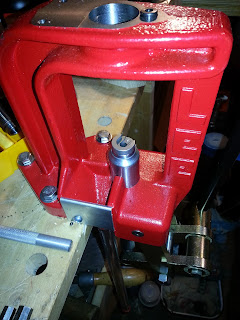Loading With A Lee Breech Lock Classic Cast Press and Ultimate Rifle 4 Die Set
This post hopefully will answer some questions about the mystery of reloading metallic cases. This will be just a basic tutorial and there are quite a few on the web but this is how I do it and it works.
Currently I have decided to work up a specific target load for my rifle. What I'm doing will create an accurate load that is specific to my rifle. The same load used in your rifle may or may not be as accurate. I am starting with new brass and the first rounds through my rifle will form fit the brass. I'm also starting with the bullet height specific to my rifle chamber. To do this I take an empty non primed case that can be chambered in my rifle and just barley seat a bullet. If the empty case will not fit in my chamber it will need to be sized using the Lee full sizing die and then go on to seat the bullet. I put this in the chamber and see if the bolt will close. If not I seat the bullet just a bit more until the bolt almost closes. The bullet is seated the rest of the way by pushing the bolt closed. I keep this as my reference and this is what I use to set my bullet seating die. This is called seating the bullet to the rifle lands, which is so when the bullet is chambered it is touching the rifle lands. Since these are new cases I do not have to de-prime them, clean them or size them because these particular cases are ready to go. These cases I'm using are Hornady Match cases and the bullets are Sierra 168gn Match King HPBT. I'm following a procedure more or less on the Sierra web site(Long Range Load Development).
Instructions for the press and a reloading how to as well. For more information on Lee Precision follow this link(Lee Precision)
I recommend drilling holes in a work bench and mounting this press. The press is heavy and well made. I downloaded a template but it is easy enough to make your own. I used bolts lock and fender washers and nuts. I can easily remove the press and put it away if I don't intend to use it for a while. For more information on this press follow this link(Classic Cast press)
After I determined the length of my cartridge and had a model non primed non charged cartridge to measure and compare. I put on my safety glasses and I primed my new cases. If I were reloading already fired cases I would de-prime, clean and re-size the neck if it were shot from my rifle or else I would use the full sizer included in the die set if the cases were fired from another rifle or out of size.
Case primed and ready to go into a load block to be charged with powder.
The next step is to systematically weigh powder and load each case. I used an electronic scale. Make sure you get one that comes with a weight for calibration. It is important to some how keep track of the case you are charging. The last thing you want to do is double charge a case. But these cases would over flow if double charged. Still you need to concentrate and keep your mind on your job. No distractions.
Empty cases in load block.
Loading powder into cases after being weighed.
My electronic scale.
Here I'm using an RCBS powder trickler to trickle the powder into the pan on the scale. Lee provides a powder dipper that you can use to put the powder in the pan and weigh it. They also provide you recipes where you can use the dipper without a scale for reloading but you are limited to their information. It works I have tried it on other loads but for these I want to be as accurate as possible since I'm working up long range loads.
Primed and loaded cartridges in the load block.
These instructions come with the dies and there is a lot of information on loads they recommend and how to reload using their equipment. Also there is the size of a standard case you could use to generically seat your bullet depth. These are all tested and will work for you. For more information on these dies follow this link(Ultimate Rifle Dies)
Then using my predetermined bullet seating depth I set the bullet seating die and seated my bullets.
Model of my cartridge I made.
Seating die adjusted.
Bullet ready to be seated.
Measure and compare.
Lee Ultimate 4 rifle die set. Comes with shell holder, full sizing die, neck sizing die, adjustable bullet seating die, factory crimping die, powder dipper and instructions.
Next I crimped all my reloaded shells with the crimping die.
After I sight the rifle in with these loads I will go to a firing range that has at least targets out to 200 yds if not more and work through different powder charges. That will be the topic next time. Until then have fun reloading and shooting.
Labels: Lee Breach Loading Classic Cast press, Lee Precision, Lee Ultimate 4 Rifle Die Set, Long Range Shooting, metallic cartridge reloading, reloading for long range shooting, reloading rifle cartridges




























































